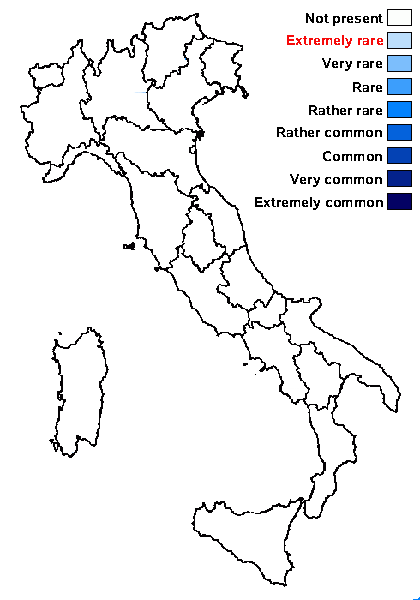Rhizocarpon mosigiae Poelt & Obermayer
Herzogia, 11: 111, 1995.
Synonyms:
Distribution:
Description: Thallus crustose, areolate, dull violet-grey, epruinose, usually without a distinct prothallus, forming 2-10 mm wide, orbicular islands on the thalli of Rimularia gibbosa. Areoles contiguous, sharply angular, 0-2-0.5 mm wide, flat to irregularly convex. Medulla white, I+ blue in basal parts. Apothecia lecideine, black, usually crowded in central parts of thallus, slightly prominent, at first flat and thinly marginate, but soon strongly convex and immarginate. Epithecium reddish brown, to brown-black, K+ purple-violet; hymenium colourless, c. 150 μm high; paraphysoids scarcely swelling at apex, without a strongly delimited pigmented cap; hypothecium brown-black. Asci 8-spored, clavate, fissitunicate, with a well-developed tholus, lacking an ocular chamber, Rhizocarpon-type. Ascospores 1-septate, at first hyaline, then blue-grey to brown, ellipsoid, straight or slightly curved, 17-22(-24) x 8-9.5(-10.5) μm, with a c. 4 μm thick halo. Photobiont chlorococcoid. Spot tests: thallus K-, C-, KC-, P-, UV-. Chemistry: thallus without lichen substances. Note: a species resembling the Mediterranean Rh. epispilum, but thallus grey and ascospores somewhat smaller; obligately parasitic of Rimularia gibbosa on siliceous boulders at high elevations; only known from the Eastern Alps (Austria); to be looked for in the Italian Alps.
Growth form: Crustose
Substrata: rocks
Photobiont: green algae other than Trentepohlia
Reproductive strategy: mainly sexual
paras Rimularia gibbosa

Predictive model
Growth form: Crustose
Substrata: rocks
Photobiont: green algae other than Trentepohlia
Reproductive strategy: mainly sexual
paras Rimularia gibbosa

Predictive model
 Index Fungorum
Index Fungorum
 GBIF
GBIF

